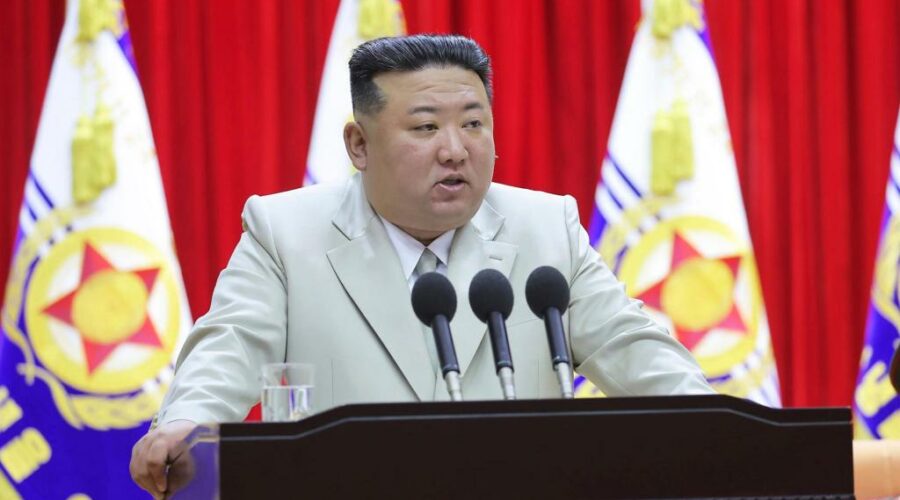North Korea says it has deployed a new nuclear attack submarine to counter US naval power – The Denver Post
By KIM TONG-HYUNG (Associated Press)
SEOUL, South Korea (AP) — North Korea said Friday it has christened a purported nuclear attack submarine it has been developing for years, a step leader Kim Jong Un described as crucial in his efforts to build a nuclear-armed navy to counter the United States and its Asian allies.
The North’s official Korean Central News Agency said the vessel – named “Hero Kim Kun Ok” – is designed to launch tactical nuclear weapons from underwater but did not specify the number of missiles it could carry and fire.
In speeches at the vessel’s launching ceremony on Wednesday and an onboard inspection on Thursday at a military shipyard, Kim expressed satisfaction the country has acquired its own nuclear attack submarine to counter the advanced naval assets of the U.S., KCNA said. In July, the U.S. docked a nuclear-capable ballistic missile submarine in South Korea for the first time since the 1980s.
Kim said the country is also pursuing a nuclear-propelled submarine and plans to remodel its existing submarines and surface vessels so they can handle nuclear weapons, describing the building of a nuclear-capable army as an “urgent task.”
Based on Kim’s comments and photos by North Korean state media, it’s likely the new submarine is the same one Kim inspected in 2019 while it was under construction, which experts then assessed as an effort to convert an existing Romeo-class submarine. The submarine appears to have at least 10 launch tubes – four of them larger than the other six – that are possibly designed for missile launches.
South Korea’s military downplayed the significance of the new submarine, insisting that North Korea was exaggerating its capabilities. The South’s Joint Chiefs of Staff said the North had to increase the size of the bridge and other parts of the original vessel to accommodate missile launch systems but that the appearance of the new submarine suggested that it could “not be operated normally.”
“There are signs of deception or exaggeration,” the Joint Chiefs of Staff said in a statement, without elaborating.
North Korea previously had been testing a variety of missiles designed to be fired from submarines as it pursued the ability to conduct nuclear strikes from underwater, which in theory would bolster its deterrent by ensuring a survivable capability to retaliate after absorbing a nuclear attack on land.
Ballistic missile submarines would also add a maritime threat to the North’s growing collection of solid-fuel weapons fired from land vehicles that are designed to overwhelm missile defenses in South Korea and Japan.
It would take considerable time, resources and technological improvements for the heavily sanctioned nation to build a fleet of at least several submarines that could travel quietly and reliably execute attacks, analysts say.
“This submarine, though heavily modified, is based on 1950s Soviet-origin technology and will have inherent limitations. Nevertheless, in terms of complicating the targeting challenges that the U.S. and its allies will face, the submarine will serve North Korea’s purposes,” said Ankit Panda, an expert with the Carnegie Endowment for International Peace.
Kim in recent weeks has been emphasizing the need to strengthen the country’s navy, a focus that some analysts say could be driven by a desire to expand military cooperation with Russia, which has suggested the possibility of combined military exercises between the countries.
There’s also speculation that Kim is preparing to visit Russia soon for a meeting with President Vladimir Putin for discussions on North Korean arms sales to refill Russian reserves drained by its war on Ukraine.
In exchange for providing Russia with artillery shells and other ammunition, North Korea could seek badly needed economic aid and also advanced weapons technologies, including those related to submarine-launched ballistic missile systems, intercontinental ballistic missiles and military spy satellites, analysts say.
But it’s unclear whether Russia, which has always closely guarded its most important weapons technologies, even from key allies like China, would be willing to provide North Korea major technology transfers in exchange for what’s likely to be limited war supplies.
“Russian assistance could be quite helpful here, but it’s unclear if Moscow would be willing to share this sensitive technology,” he said.
Kim insisted that the submarine revealed this week would be just as “daunting” to his enemies as the nuclear-propelled submarine North Korea plans to acquire in the future.
“The nuclear attack submarine, for decades a symbol of aggression against our republic, has now become a symbol of our revolutionary power to strike fear into the hearts of our despicable enemies,” KCNA quoted Kim as saying.
North Korea previously had only one known submarine capable of firing a missile, but that vessel has a single launch tube and analysts had considered it a test platform, rather than an active operational weapons system.
North Korea has an estimated about 70-90 diesel-powered submarines in one of the world’s largest submarine fleets. But they are mostly aging subs capable of launching only torpedoes and mines, not missiles.
Kim Inae, a spokesperson at South Korea’s Unification Ministry, which handles inter-Korean affairs, said during a briefing it was “deplorable” that North Korea was continuing to channel its limited resources into developing weapons while ignoring the struggles of its deeply impoverished people.
She didn’t provide a specific answer when asked whether Seoul believes Russia might have provided technological assistance to the North on its new submarine.
KCNA said the launching of the submarine was timed for the 75th anniversary of the country’s founding, which falls on Saturday and was to be marked by festivities, including a paramilitary parade.
Source: Read Full Article

